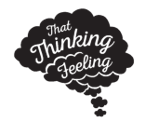Why we believe in ghosts
This is the third and final of this year's spooky as heck Hallowe’en blogs. The others are on superstition (also by me) and déjà vu (a guest blog from Courtney Aitken, a déjà vu researcher).
Do ghosts exist? I straight up do not know the answer to this question. I’ve never encountered a ghost myself, but I like to keep an open mind about these things. What I can tell you with absolute certainty is that not every reported encounter with a ghost is, you know, an actual encounter with a ghost. Sometimes it’s carbon monoxide poisoning, or a vivid dream, or magnets.
Yes, magnets. Now, I know Insane Clown Posse don’t want to hear about magnets from me, a scientist, buuuuuuut they’re a pair of dingdongs who don’t read this blog, so…
Magnets!
It’s possible to make people believe that they’re sensing a ghostly ‘presence’ by applying a complex magnetic field to the right side of the head. This is because ghosts really love magnets. Hang on, no, it’s because magnets are made of ghosts. Wait, wait, I’ll get there in a second.
Most fridges are haunted because of all the magnets
OK, do you remember learning about electromagnets? Basically, if you change the magnetic field near something that can conduct electricity (a conductor), it will cause a change in voltage in the conductor. In school, you might have learned about this by passing a magnet through a coil of wire.
The neurons that make up your nervous system are also conductors. Imagine you have accidentally put your hand on a hot saucepan. Your body wants to minimise the damage, so it starts passing a message up to the brain: hot thing, move the hand! To get to the part of the brain that deals with moving the hand, the message has to pass through a chain of neurons, and it has to do it as quickly as possible. Usually, within an individual neuron, the quickest way to pass this message from one end of the neuron to the other is through a nerve impulse. I won’t bore you with the chemistry behind it, but the nerve impulse works by changing the relative electrical charge between the inside and the outside of the neuron all along the length of the neuron. The message gets to the brain, the decision is made to move the hand, and a new message speeds back down the arm to the muscles.
So – when you change the magnetic field around your head, that can affect the electrical charge inside the neurons, at first causing them to become really active and then tiring them out, because just like muscles, neurons need to rest sometimes.
Now we understand the principle behind the magnets, the next question is why the right side of the head? Michael Persinger believes that our sense of who we are as individuals is located in the left side of the brain. He also believes that the right hemisphere has a similar process that is normally much ‘quieter’ than the left side, but can become highly active under the right circumstances, like, say, a magnetic field. When we sense a ghostly ‘presence’ as the right hemisphere becomes more active than usual, we’re actually sensing our selves, but not our usual selves. Not everyone is susceptible to magnetic fields to the same degree, which might explain why some people experience ghosts and other people don’t. You should also know that there’s some disagreement about whether magnetic fields can do this at all.
Fine, you might say, you can do that in the lab with fancy machines. But surely not every haunted house comes equipped with a giant magnet.
If you absolutely have to enter a spooky cabin in the middle of nowhere, be sure to check the basement for magnets
Well, first of all, yes, they do! The Earth is a giant electromagnet, with a magnetic field that is stronger in some places than in others and that varies from second to second due to things like the solar wind. I’m no physicist, so I won’t attempt any more depth – hopefully you are happy to take my word for it.
Secondly, you don’t actually need that big a magnet. There’s a place in the north-west of England called Muncaster Castle. Muncaster has a bedroom called the Tapestry Room, which is reputedly super haunted. People staying in the bed overnight have reported all manner of ghostly things like hearing footsteps and children crying, feelings of being watched or severe foreboding, headaches, dizziness…
Enter Jason Braithwaite and Maurice Townsend, investigators who carried out a magnetic survey of the Tapestry Room. There’s a massive magnetic anomaly around the bed, but not around the rest of the room, or around the beds in any nearby rooms – meaning that someone getting into this particular bed, or even rolling over in the night, could be subjected to quite a change in the magnetic field around their head. The source of this magnetic field? Probably the bed itself, which is made of iron.
Braithwaite has done a lot of research on the magnetic fields in allegedly haunted places. In 2008, he did a calculation: only 2 of the 45 places he’d investigated had strong magnetic fields that might explain the ghostly experiences that people had there. No matter how much ghosts like magnets, there must be something else going on. Something like… expectation.
The role of prior knowledge
What if knowing that a place is supposed to be haunted makes you more likely to have some kind of ghostly experience there? Richard Wiseman and his colleagues tested this idea in two places that are both supposed to be haunted: Hampton Court Palace, near London, and the South Bridge Vaults, in Edinburgh. In both locations, visitors were asked mark on a map any ‘unusual experiences’ they had, and in both locations, visitors reported more unusual experiences in areas which were more ‘haunted’ (i.e. past visitors had reported higher numbers of unusual experiences in these areas). This was the case even for visitors who had no knowledge about which areas were more ‘haunted’.
In Hampton Court Palace, the more haunted areas were also the areas with high variation in magnetic fields, but that wasn’t the case in the South Bridge Vaults. You might think this destroys the possibility of prior knowledge having a role in ghostly experiences, but there was another factor in the South Bridge Vaults that could explain people’s tendency to report more unusual experiences in some areas: those were also areas that were particularly large, high-ceilinged and dark. They looked like haunted places! So maybe it’s more about how suggestible someone is than how much prior knowledge they have…
In another study, Wiseman and colleagues told visitors to Hampton Court that two particular areas had either been associated with increased reports of unusual experiences, or with very few reports of unusual experiences. These two areas were the same every time, it’s just the people visiting were told different things, so the findings can’t be explained by the areas actually being haunted. The visitors to these areas were asked to fill out a form about any unusual experiences they had, as well as a questionnaire which included a question about their belief in ghosts. Based on this question, the researchers classified them as believers or disbelievers. Believers reported more unusual experiences than disbelievers, and were more likely to attribute those experiences to ghosts. They also reported more unusual experiences if they were in the group that was told the areas had been associated with increased reports of unusual experiences. So… there is definitely some role of suggestibility, but this isn’t the only characteristic that can affect whether you’re likely to have unusual experiences – other characteristics include being sensitive to small perceptions that other people might miss, and, not surprisingly, whether you have any paranormal beliefs.
AND NOW
IT’S TIME TO TELL YOU ABOUT THE RESEARCHERS WHO BUILT A HAUNTED ROOM.
They built the room about 10 years ago and despite their cavalier attitudes to the possibility of Pipes moving in they are still alive and well, at least as far as I can tell from a quick Google.
The haunted room itself was a circular one, built inside a North London flat. The researchers then invited ghosts to come and stay in the flat. No, just kidding, they put some equipment nearby that generated complex magnetic fields and infrasound inside the room.
Hold up, what’s infrasound?
Well, you can think of it like the inverse of a dog whistle – it’s a sound that’s too low for humans to hear, made by things like storms, machinery, and meteors.
Meteors: also full of ghosts
Though we can’t hear infrasound, we can often still sense it through the vibrations it makes in our bodies, which can cause changes in ear pressure, headaches, discomfort, apprehension, disorientation… and we may attribute those experiences to paranormal activity.
Back to the haunted room! The researchers asked their participants to spend 50 minutes in the room. Participants were allotted to one of four groups: infrasound only, magnetic fields only, both, and neither. During their time in the room they recorded any unusual sensations and when and where they happened. Quite a lot of unusual sensations were recorded, but it didn’t seem to matter whether the magnetic fields or the infrasound were on or off. The researchers concluded that suggestibility was more important than infrasound or magnetic fields when it came to having unusual experiences, but they didn’t check out the levels of ambient infrasound (i.e. the normal infrasound coming from everyday life in North London, which as a resident I can tell you is a pretty fucking noisy place) before they added their own infrasound, so it could well have been that the added infrasound was simply a drop in the ocean.
So… are there ghosts?
At first, I wasn’t sure how to conclude this post. There’s no definitive explanation of why we believe we’ve had paranormal encounters, though there are hints at some factors. At first, I was inclined to suggest that ghosts don’t like being researched and purposely piss about with the results any time someone tries to do an experiment.
But then, as I was writing this, my utterly ghost-unbelieving boyfriend said that he thought whether ghosts exist depended on whether we were talking about perception or sensation. This hadn’t occurred to me, but I think he’s right. He’s referring to one of the big problems of psychology: is my subjective experience of the world anything like your subjective experience of the world?
Information is coming into your brain via your senses all the time. Here’s some of the sensory information that both my boyfriend and I are experiencing right now: the give of the sofa we’re sitting on, the temperature of the air in the room, and the noise of two Americans commentating on Super Mario 64 speedrun bingo (we’re big ol’ nerds in this house – though I’m not sure that you expected anything else given that I literally write about psychology for fun). The information coming in via each of our separate sets of senses is, broadly speaking, similar, but we might be making quite radically different interpretations of that information. For example, as he runs hot and I run cold, the room feels warmer to him than it does to me. This is the difference between sensation (information) and perception (interpretation).
Whether ghosts exist, then, is perhaps a matter of perception. Two people might both experience a strong electromagnetic field, but one person might think, feels weird in here and the other person might think, this place is haunted. So here’s my conclusion: ghosts do exist, but possibly only perceptually speaking.



